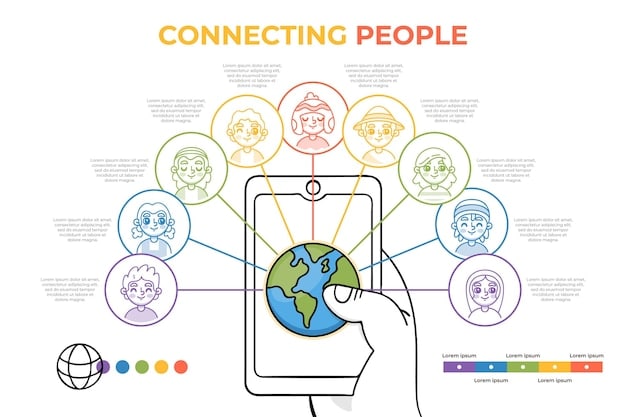Measuring Inclusive Communication Success: Key Metrics & Reporting

Measuring inclusive communication success involves tracking various key metrics and establishing robust reporting strategies to ensure messaging is accessible, equitable, and resonates with diverse audiences, fostering genuine connection and understanding.
In today’s interconnected world, effective communication is paramount, yet its true power lies in its inclusivity. The challenge, for many organizations, is not merely to communicate, but to communicate in a way that truly embraces and reflects the diversity of their audience. This article delves into the critical endeavor of Measuring Inclusive Communication Success: Key Metrics and Reporting Strategies, providing a comprehensive guide for assessing and enhancing your outreach efforts.
Understanding the Core of Inclusive Communication
Inclusive communication moves beyond simply transmitting information; it’s about ensuring every individual feels seen, heard, and understood, regardless of their background, identity, or ability. This foundational principle demands a shift in mindset, moving from a one-size-fits-all approach to one that actively considers and accommodates diverse needs. It recognizes that barriers to communication can be subtle, stemming from language, cultural nuances, accessibility issues, or unconscious biases embedded within messaging. Organizations committed to genuine inclusion understand that a diverse workforce and customer base require communication strategies that mirror this rich tapestry.
The true essence of inclusive communication lies in its active pursuit of equity and belonging. It involves a systematic review of all communication channels, content, and delivery methods to identify and eliminate potential exclusionary elements. This proactive stance not only enhances an organization’s reputation but also strengthens relationships with stakeholders, customers, and employees by fostering trust and mutual respect. Without a clear understanding of what makes communication truly inclusive, efforts risk falling short of their intended impact, becoming performative rather than transformative. It’s about designing messages from the ground up with diversity in mind, rather than retrofitting them. This holistic approach ensures that every step of the communication process, from ideation to delivery, is filtered through an inclusive lens, maximizing reach and effectiveness.
Defining Inclusive Communication: Beyond Translation
While translation is often a component, inclusive communication extends far beyond merely converting words from one language to another. It encompasses cultural relevance, accessibility for individuals with disabilities, and the avoidance of jargon or assumptions that might exclude certain groups. It’s about crafting messages that resonate authentically with diverse lived experiences.
- Cultural Competence: Understanding and respecting cultural differences in communication styles and norms.
- Accessibility: Ensuring content is usable by individuals with visual, auditory, cognitive, or motor impairments.
- Linguistic Diversity: Accommodating various languages and dialects, recognizing nuanced meanings.
- Bias-Free Language: Eliminating stereotypes, assumptions, and discriminatory terms from messaging.
The Impact of Exclusionary Practices
When communication is not inclusive, the consequences can be far-reaching, leading to disengagement, misunderstanding, and a breakdown of trust. It can alienate potential customers, reduce employee morale, and damage an organization’s brand image. In an era where authenticity is highly valued, exclusionary practices can quickly erode credibility and foster an environment of disconnect rather than connection.
The proactive adoption of inclusive communication strategies is not just a moral imperative but also a strategic business advantage. Research consistently shows that companies prioritizing diversity and inclusion, reflected in their communication, outperform their peers. It enables better decision-making by incorporating a wider range of perspectives, fosters innovation through diverse thought, and attracts top talent who seek inclusive environments. Ultimately, it builds a stronger, more resilient organization prepared for the complexities of a globalized world.
Identifying Key Metrics for Inclusive Communication
To effectively measure the success of inclusive communication efforts, organizations must move beyond anecdotal evidence and embrace data-driven insights. This requires identifying specific, measurable metrics that reflect the diversity, accessibility, and engagement levels of their communication. Metrics should be tailored to the organization’s unique context, goals, and target audiences, recognizing that what works for one might not work for another. The selection process should involve a cross-functional team to ensure a holistic view, integrating marketing, HR, corporate communications, and accessibility specialists. This ensures that metrics capture the full spectrum of inclusivity, from internal employee engagement to external customer satisfaction.
The starting point for metric identification involves reviewing existing communication channels and content, assessing their current inclusiveness. This baseline assessment helps in identifying areas of strength and weakness, guiding the selection of metrics that will provide the most actionable insights. For instance, if an organization primarily communicates through visual content, metrics related to image diversity and alt-text usage become particularly relevant. If a significant portion of the audience is non-native English speakers, language accessibility metrics would take precedence. The key is to be strategic and focused, avoiding the temptation to measure everything, which can lead to data overload without meaningful insights.

Reach and Representation Metrics
These metrics focus on who is receiving the message and how diverse voices are represented within the content itself. They help ascertain whether communication is effectively reaching all target demographics and reflecting diverse perspectives. Analyzing these metrics involves scrutinizing audience demographics against content representation to spot any significant disparities. This can involve conducting content audits, analyzing media coverage, or surveying audience perceptions.
- Audience Demographics: Tracking the diversity of individuals engaging with your content (e.g., age, gender, ethnicity, location, disability status). Utilise analytics from websites, social media platforms, and email campaigns.
- Content Diversity Index: Measuring the representation of diverse groups within your communication materials (e.g., imagery, testimonials, case studies). This can involve manual audits or AI-powered content analysis tools.
- Linguistic Accessibility: Analyzing the number of languages offered and the engagement rates across different language versions of content.
- Reach Across Platforms: Assessing if different demographics are reached proportionally across various communication channels (e.g., social media, traditional media, community forums).
Engagement and Impact Metrics
Beyond reach, it’s crucial to understand how diverse audiences are interacting with and being impacted by the communication. These metrics delve into the quality of engagement and the perceived effectiveness of inclusive messaging. Understanding engagement rates provides insight into how well the message resonates and whether it encourages desired actions or fosters positive sentiment.
Qualitative Feedback and Sentiment Analysis
Quantitative metrics provide valuable data, but qualitative insights offer depth and nuance. Collecting feedback directly from diverse audiences through surveys, focus groups, and interviews can uncover subtle biases or communication breakdowns that numeric data might miss. Sentiment analysis of social media mentions and online reviews can also gauge public perception of inclusivity. This combines the “what” with the “why,” offering a richer understanding of communication effectiveness. It allows for a deeper dive into specific instances where communication excelled or fell short, providing targeted areas for improvement.
Collecting and analyzing this qualitative data is an iterative process, requiring ongoing dialogue and adaptation. It’s not a one-time exercise but an integral part of continuous improvement. The insights gained from qualitative feedback can inform future content creation, channel selection, and overall inclusive communication strategy. This ensures that the organization remains responsive to the evolving needs and perceptions of its diverse audience, building a reputation for genuine inclusivity rather than just performative efforts.
Establishing Robust Reporting Strategies
Once key metrics are identified, the next critical step is to establish robust reporting strategies that transform raw data into actionable insights. Effective reporting moves beyond simply presenting numbers; it tells a story about the organization’s progress in fostering inclusive communication, highlighting successes, identifying areas for improvement, and informing future strategies. A well-designed reporting framework ensures that data is collected consistently, analyzed accurately, and presented clearly to relevant stakeholders, from communication teams to senior leadership. It also ensures transparency and accountability for the organization’s commitment to diversity and inclusion.
The reporting framework should define the frequency of reports (e.g., monthly, quarterly, annually), the audience for each report, and the specific metrics to be included. Visualization plays a crucial role in making complex data digestible and impactful; dashboards, charts, and graphs can effectively illustrate trends and comparisons. Furthermore, reports should always include qualitative insights alongside quantitative data, providing context and deeper understanding. This holistic approach helps in paint a complete picture, demonstrating not just what happened, but why it happened, enabling more informed decision-making and strategic adjustments. Establishing a clear reporting structure ensures that insights are consistently captured and communicated across the organization.
Dashboard Development and Visualization
Creating intuitive dashboards for tracking inclusive communication metrics is essential for ongoing monitoring and quick insights. Visual representations of data, such as charts, graphs, and heatmaps, can make complex information easily digestible, allowing stakeholders to grasp trends and identify patterns at a glance. Dashboards should be customizable, allowing users to drill down into specific data points or filter by different demographic groups. The design should prioritize clarity, accessibility (e.g., color contrast, alternative text for images), and user-friendliness, ensuring that information is accessible to individuals with diverse needs and roles within the organization.
Regular Reporting Cadence and Stakeholder Engagement
Establishing a consistent reporting cadence—whether monthly, quarterly, or annually—ensures that progress is regularly reviewed and discussed. These reports should be shared with key stakeholders, including marketing teams, HR, senior leadership, and diversity and inclusion committees. Facilitating discussions around these reports encourages collective ownership of inclusive communication goals and fosters a culture of continuous improvement. The discussions should focus on interpreting the data, identifying root causes for trends, and brainstorming actionable strategies to address challenges and build upon successes.
Timely and transparent reporting builds trust and accountability. It demonstrates the organization’s commitment to measuring and improving its inclusive communication practices, moving beyond lip service to concrete action. The engagement of senior leadership is particularly vital, as their commitment sets the tone for the entire organization, signaling the strategic importance of these efforts. This ensures that inclusive communication is not just an initiative but an integral part of the organizational culture and operational strategy.
Leveraging Technology for Measurement and Reporting
The advancement of technology offers powerful tools for measuring and reporting inclusive communication success, streamlining data collection, analysis, and visualization. Automation can significantly reduce manual effort, allowing teams to focus more on strategy and less on data compilation. Leveraging artificial intelligence (AI) and machine learning (ML) can provide deeper insights, such as sentiment analysis of diverse online conversations or automated content audits for bias detection. These technologies can process vast amounts of data far more efficiently and accurately than manual methods, providing real-time insights that enable rapid response and adaptation.
Choosing the right technological solutions is paramount. This might involve adopting specialized communication analytics platforms, enhancing existing CRM or HR systems with diversity metrics, or integrating AI-powered content analysis tools. The key is to select tools that are scalable, compatible with existing systems, and provide actionable intelligence rather than just raw data. Investing in appropriate technology is not merely about efficiency but about gaining a competitive edge in fostering truly inclusive interactions. It empowers organizations to move from reactive adjustments to proactive, data-driven strategies that anticipate communication needs and effectively address them.

AI and Machine Learning for Content Analysis
AI and machine learning tools can be invaluable for analyzing large volumes of text and multimedia content for inclusivity. These technologies can identify instances of biased language, assess image diversity, detect gender representation imbalances, and even estimate content readability for various audiences. By automating these analyses, organizations can gain a comprehensive understanding of their communication’s inclusivity at scale, flagging potential issues before they cause harm. These tools go beyond surface-level checks, capable of identifying subtle patterns and implicit biases that human reviewers might miss.
- Bias Detection: Identifying and flagging language patterns that might perpetuate stereotypes or show unconscious bias.
- Readability Scores: Assessing content complexity and suggesting improvements for wider audience comprehension.
- Image Recognition: Analyzing visual content for diverse representation and appropriate portrayal.
- Sentiment Analysis: Gauging the emotional tone of communication and audience responses across different demographics.
Integrated Communication Analytics Platforms
Modern communication analytics platforms can integrate data from various channels—websites, social media, email campaigns, internal communication systems—to provide a holistic view of inclusive communication effectiveness. These platforms offer centralized dashboards, robust reporting features, and often include built-in AI capabilities for deeper insights. By consolidating data, organizations can identify cross-channel trends, pinpoint successful strategies, and optimize future communication efforts for maximum inclusivity. Such platforms empower communication professionals with a comprehensive toolkit for managing and enhancing their outreach.
The integration of data across platforms enables a truly unified approach to inclusive communication measurement. Instead of fragmented insights from disparate systems, organizations gain a consistent, overarching understanding of their performance. This consolidated view facilitates more strategic decision-making, allowing resources to be allocated effectively to areas that will yield the greatest impact on inclusivity. The real-time nature of many integrated platforms means that insights are fresh and actionable, supporting agile adjustments to communication strategies.
Overcoming Challenges in Measurement
Measuring inclusive communication success is not without its difficulties. Organizations often encounter challenges ranging from data collection complexities to the subjective nature of certain inclusivity indicators. One primary hurdle is the sheer volume and disparate nature of communication data, spread across numerous platforms and channels, making aggregation and consistent analysis a significant undertaking. Another challenge lies in defining what constitutes “inclusive” for diverse audiences, as perceptions can vary widely and evolve over time, requiring continuous refinement of metrics and measurement approaches. Overcoming these obstacles requires a strategic and adaptable approach, embracing both quantitative rigor and qualitative insights.
Addressing these challenges demands a multi-faceted strategy that combines technological solutions with human insight and continuous learning. It involves investing in robust data infrastructure, fostering a culture of data literacy, and actively engaging with diverse communities to validate measurement frameworks. By anticipating these hurdles and developing proactive mitigation strategies, organizations can ensure their inclusive communication measurement efforts remain effective, accurate, and truly reflective of their commitment to diversity. The intent should always be to foster genuine understanding and connection, not just to tick boxes.
Data Silos and Inconsistent Definitions
A common challenge is fragmented data residing in different systems, making it difficult to gain a unified view of communication performance across diverse audiences. Establishing consistent definitions for key metrics across all departments and platforms is crucial. This often requires cross-functional collaboration and the implementation of shared data governance policies to ensure data integrity and comparability. Without a unified approach, insights can be contradictory or incomplete, hindering accurate assessment of inclusivity efforts. Organizations must invest in data integration tools and processes that break down silos, enabling a comprehensive and cohesive view of their communication ecosystem.
Subjectivity and Nuance in Qualitative Data
While invaluable, qualitative feedback on inclusivity can be subjective and difficult to quantify or categorize consistently. Interpreting sentiment, cultural relevance, and perceived authenticity requires careful consideration and often involves human judgment. Developing clear rubrics for qualitative analysis, training analysts on sensitivity and nuance, and triangulating qualitative findings with quantitative data can help mitigate subjectivity and enhance the reliability of insights. The goal is to extract meaningful patterns and themes from diverse voices, ensuring that feedback genuinely informs and shapes communication strategies.
Continuous Evolution of Inclusivity
The understanding of inclusivity is not static; it evolves as societies become more aware of diverse needs and perspectives. This means that communication strategies and their corresponding metrics must also be adaptable. What is considered inclusive today may not be sufficient tomorrow. Organizations need to foster a culture of continuous learning and adaptation, regularly reviewing their measurement frameworks and communication practices to align with evolving best practices and audience expectations. This ongoing commitment ensures that efforts remain relevant and truly impactful in a dynamic world, reflecting true dedication to belonging.
Future Trends in Inclusive Communication Measurement
The landscape of inclusive communication measurement is continually evolving, driven by technological advancements, shifting societal expectations, and a deeper understanding of human diversity. Looking ahead, several trends are poised to reshape how organizations assess their inclusivity efforts, moving towards more predictive, personalized, and integrated approaches. The emphasis will increasingly be on proactive measures that anticipate communication needs rather than reactive responses to feedback. This forward-looking perspective will necessitate continuous innovation in measurement techniques and a greater reliance on advanced analytics to uncover subtle patterns of exclusion or engagement.
A significant trend involves the integration of inclusive communication metrics directly into broader business KPIs, moving it from a niche concern to a core strategic imperative. This holistic approach recognizes that inclusive communication is not just a nice-to-have but a fundamental driver of business success, influencing everything from brand reputation to talent acquisition and customer loyalty. The future of measurement will empower organizations to build truly adaptive communication strategies that resonate with an increasingly diverse and dynamic world, ensuring every voice is heard and valued. It will also foster greater accountability and investment in this critical area, recognizing its profound impact.
Predictive Analytics for Proactive Insights
Future trends will likely see greater adoption of predictive analytics to anticipate communication needs and potential areas of exclusion. By analyzing historical data and emerging patterns, organizations can proactively tailor messages, select appropriate channels, and identify potential accessibility barriers before they impact audiences. This shift from reactive to proactive measurement will enable more efficient resource allocation and more impactful communication strategies, ensuring messages are inclusive from conception. Predictive models can forecast the likely impact of specific communication choices on diverse audience segments, allowing for adjustments before widespread dissemination.
Hyper-Personalization and Audience Segmentation
As technology advances, so too will the ability to hyper-personalize inclusive communication based on granular audience segmentation. This means not just tailoring messages by broad demographic categories but understanding individual preferences, communication styles, and accessibility needs within diverse groups. Measurement will focus on the effectiveness of these highly personalized approaches, assessing how well messages resonate at an individual level while maintaining brand coherence and inclusive values. This level of detail will allow organizations to build deeper, more meaningful connections with every segment of their audience, enhancing loyalty and engagement.
Integration with ESG Reporting
Inclusive communication metrics will become increasingly integrated into broader Environmental, Social, and Governance (ESG) reporting frameworks. As stakeholders demand greater transparency and accountability for social impact, organizations will need to demonstrate their commitment to inclusivity through quantifiable data. This trend elevates inclusive communication from a departmental concern to a strategic business imperative, driving investment and integration across corporate functions. It positions inclusive communication as a core component of sustainable business practices, reflecting a holistic commitment to societal well-being and responsible corporate citizenship.
| Key Point | Brief Description |
|---|---|
| 🎯 Audience Reach | Assess if your communication reaches all intended diverse groups proportionally. |
| 💡 Content Diversity | Evaluate representation of various groups in visuals, stories, and language. |
| 👂 Engagement & Feedback | Measure diverse audience interaction and actively solicit their perspectives. |
| ⚙️ Reporting & Technology | Implement consistent dashboards and leverage AI for actionable insights. |
Frequently Asked Questions
▼
Measuring inclusive communication is crucial because it ensures an organization’s messages effectively reach and resonate with all audience segments, regardless of background or ability. It helps identify gaps, build trust, enhance brand reputation, and foster a more equitable and welcoming environment for everyone. Without measurement, efforts might be well-intentioned but miss their mark, leading to missed opportunities and potential alienation of key stakeholders.
▼
Key challenges include fragmented data across various platforms, defining subjective inclusivity criteria, and the continuous evolution of what constitutes inclusive language and practices. It also involves overcoming data silos, ensuring consistent metric definitions across departments, and sensitively interpreting qualitative feedback from diverse groups. These complexities require a thoughtful, adaptive approach and robust technological support to manage effectively.
▼
Technology, particularly AI and machine learning, can significantly enhance inclusive communication measurement by automating content analysis for bias, assessing readability, and recognizing diverse representation in visuals. Integrated communication analytics platforms can consolidate data from various channels, providing comprehensive dashboards and enabling predictive analytics for proactive strategy adjustments. These tools streamline data collection and provide deeper, more actionable insights faster.
▼
A Content Diversity Index measures the representation of various demographic groups within an organization’s communication materials, including imagery, narratives, and testimonials. It’s useful because it provides a quantitative way to assess whether content reflects the diversity of the target audience or society at large. A higher index suggests more inclusive content, helping organizations identify and rectify areas where representation might be lacking, ensuring a broader appeal and stronger connection.
▼
The frequency of reporting depends on the organization’s specific goals and communication cycles, but generally, a quarterly or semi-annual cadence is effective for strategic reviews. Key stakeholders might benefit from monthly snapshots for tactical adjustments, while comprehensive annual reports can inform long-term strategy and demonstrate progress against broad DEI objectives. Consistent reporting ensures ongoing accountability and allows for timely pivots in communication strategy based on evolving insights.
Conclusion
Measuring inclusive communication success is not merely a quantitative exercise but a journey of continuous learning and adaptation. By diligently tracking key metrics, establishing robust reporting strategies, and leveraging advanced technologies, organizations can move beyond good intentions to demonstrable impact. The commitment to inclusive communication, backed by solid measurement, strengthens relationships, fosters trust, and builds a truly equitable and resonant presence in an increasingly diverse world. This proactive approach ensures that every voice is not only heard but also deeply understood, forging connections that transcend differences.





